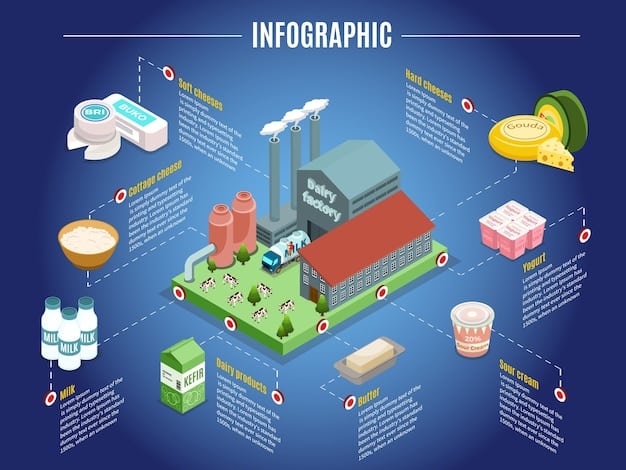Electric Vehicle Battery Recycling: 95% Material Recovery by 2026

Electric Vehicle Battery Recycling Breakthrough: New Technology Promises 95% Material Recovery by 2026, revolutionizing the industry with its potential for near-complete material recovery, addressing a crucial sustainability challenge and paving the way for a circular economy in electric vehicle battery production and use.
The future of electric vehicles hinges not only on their performance and affordability but also on the sustainability of their batteries. A groundbreaking development promises to reshape the landscape of EV battery recycling: a new technology aiming for Electric Vehicle Battery Recycling Breakthrough: New Technology Promises 95% Material Recovery by 2026. This innovation could dramatically reduce waste and dependency on raw materials.
The Urgent Need for EV Battery Recycling
As the electric vehicle market accelerates, the sheer volume of batteries reaching the end of their life cycle is becoming a pressing concern. Efficient and sustainable recycling methods are essential to mitigate environmental impact and recover valuable materials.
Environmental Concerns
Traditional disposal methods, such as landfilling, pose significant risks, including soil and water contamination due to the leaching of harmful chemicals. Recycling offers a cleaner alternative.
Resource Depletion
The extraction of raw materials like lithium, cobalt, and nickel for battery production is resource-intensive and can have detrimental environmental and social consequences. Recycling helps reduce the demand for these newly mined materials.
- Reduces environmental pollution from landfills.
- Conserves valuable and finite resources.
- Decreases the carbon footprint associated with mining.
- Promotes a circular economy for EV batteries.
Effective EV battery recycling is no longer a luxury but a necessity for a sustainable EV ecosystem. The development of technologies capable of high material recovery rates is a critical step towards achieving this goal.
The 95% Recovery Technology: How It Works
The new technology promising a 95% material recovery rate represents a significant leap forward in EV battery recycling. But how does it achieve such impressive results?
Advanced Hydrometallurgical Processes
The technology utilizes advanced hydrometallurgical processes, which involve using chemical solutions to extract valuable materials from spent batteries. These processes are more efficient and environmentally friendly than traditional methods.
Closed-Loop System
A key feature is the implementation of a closed-loop system, minimizing waste and ensuring that all materials are either recovered or safely disposed of. This reduces the risk of environmental contamination.

- Precise chemical control for maximum material extraction.
- Reduced energy consumption compared to pyrometallurgical methods.
- Capability to handle various battery chemistries.
- Minimal waste generation through closed-loop operation.
The 95% recovery rate is achieved through a combination of innovative chemical processes and a commitment to environmental stewardship, positioning this technology as a game-changer in the EV battery recycling industry.
Benefits of High Material Recovery
Achieving a 95% material recovery rate in EV battery recycling unlocks a multitude of benefits, spanning environmental protection, economic advantages, and resource security.
Environmental Protection
By recovering nearly all valuable materials, the technology drastically reduces the need for mining new resources, minimizing habitat destruction and pollution associated with extraction processes.
Economic Advantages
The recovered materials can be reused in the production of new batteries, lowering manufacturing costs and reducing reliance on global supply chains. This can lead to more affordable EVs.
Resource Security
High material recovery enhances resource security by creating a domestic supply of critical battery components, insulating the EV industry from price volatility and geopolitical risks.
The economic and environmental benefits of high material recovery make it a crucial component of a sustainable EV future. This technology not only addresses the immediate challenge of battery waste but also lays the foundation for a circular economy.
Challenges and Opportunities
While the 95% material recovery technology holds immense promise, its widespread implementation faces certain challenges and presents significant opportunities.
Scaling Up Operations
One of the main challenges is scaling up the technology to handle the growing volume of end-of-life EV batteries. This requires significant investments in infrastructure and logistics.
Standardization of Battery Designs
The lack of standardization in battery designs and chemistries can complicate the recycling process. Efforts to standardize batteries can streamline recycling and improve efficiency.

Government Support and Regulations
Supportive government policies and regulations are crucial to incentivize recycling and ensure that manufacturers take responsibility for the end-of-life management of their batteries.
- Investment in research and development to further improve recycling technologies.
- Creation of a robust collection and transportation network for end-of-life batteries.
- Collaboration between battery manufacturers, recyclers, and policymakers.
- Public awareness campaigns to promote the importance of EV battery recycling.
Overcoming these challenges and seizing these opportunities will pave the way for a robust and sustainable EV battery recycling industry, ensuring that the benefits of electric vehicles are realized without burdening the environment.
The Role of Automakers and Consumers
The successful adoption of advanced EV battery recycling technologies requires the active participation of both automakers and consumers. Their actions can significantly influence the sustainability of the EV lifecycle.
Automaker Responsibility
Automakers have a crucial role in designing batteries that are easier to recycle and in establishing collection programs for end-of-life batteries. Some are already investing in recycling initiatives.
Consumer Engagement
Consumers can contribute by properly disposing of their EV batteries through designated channels and by supporting automakers and recycling companies that prioritize sustainability.
Extended Producer Responsibility (EPR)
Implementing EPR schemes, where manufacturers are responsible for the entire lifecycle of their products, can incentivize greater investment in recycling infrastructure and technologies.
With collaborative efforts from automakers, consumers, and policymakers, the EV industry can transition to a circular economy, minimizing waste and maximizing the value of battery materials.
Looking Ahead: The Future of EV Battery Recycling
The innovation promising Electric Vehicle Battery Recycling Breakthrough: New Technology Promises 95% Material Recovery by 2026 offers a glimpse into the future of EV battery recycling. What can we expect in the years to come?
Technological Advancements
Continued research and development will likely lead to even more efficient and environmentally friendly recycling technologies, potentially pushing recovery rates beyond 95%.
Increased Recycling Capacity
As the EV market grows, recycling capacity will need to expand to handle the rising volume of end-of-life batteries. This will require significant investments in new facilities and infrastructure.
Standardization and Automation
Greater standardization of battery designs and increased automation of recycling processes can improve efficiency and reduce costs.
The future of EV battery recycling is bright, with the potential to create a sustainable and circular economy for electric vehicle batteries. The pursuit of innovative technologies and collaborative efforts will be key to realizing this vision.
| Key Point | Brief Description |
|---|---|
| ♻️ 95% Recovery | New tech aims for 95% material recovery by 2026. |
| 🌱 Environmental Benefits | Reduces mining, pollution, and resource depletion. |
| 💰 Economic Gains | Lowers battery production costs, increases resource security. |
| 🤝 Collaboration | Automakers, consumers, and governments must work together. |
FAQ
▼
A 95% recovery rate signifies a near-complete recovery of valuable materials from EV batteries, reducing waste and dependence on newly mined resources, fostering a sustainable lifecycle.
▼
The technology utilizes advanced hydrometallurgical processes within a closed-loop system to efficiently extract materials like lithium, cobalt, and nickel while minimizing environmental impact.
▼
It significantly reduces the need for mining, prevents soil and water contamination from landfills, and lowers the carbon footprint associated with battery production.
▼
Automakers are crucial in designing recyclable batteries, establishing collection programs, and investing in recycling technologies to ensure responsible end-of-life management.
▼
Consumers can properly dispose of EV batteries through designated channels and support companies prioritizing sustainability, contributing to a circular economy for electric vehicles.
Conclusion
The prospect of achieving 95% material recovery in EV battery recycling by 2026 marks a pivotal moment for the electric vehicle industry. By embracing innovative technologies, fostering collaboration, and prioritizing sustainability, we can pave the way for a cleaner, more resource-efficient future, ensuring that the benefits of electric mobility are realized without compromising the health of our planet.





